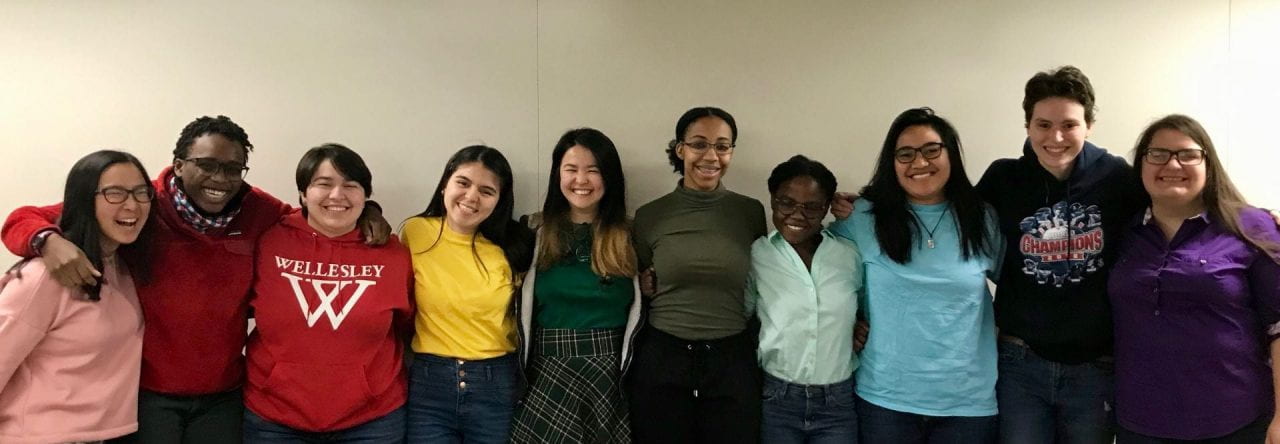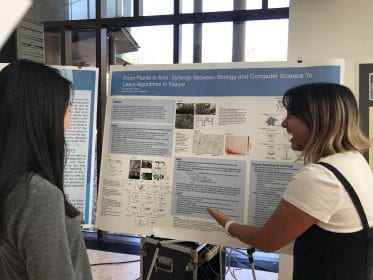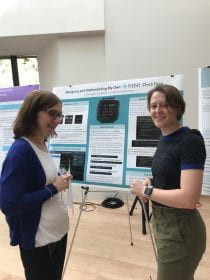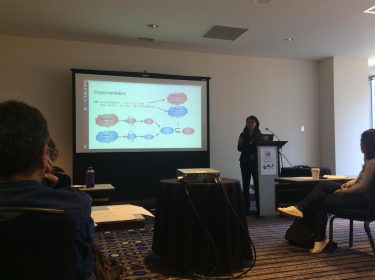This project displays posters of non-binary folk and women of color in technology as inspiration to our current CS students. Almost all the role models in technology are white males (for example, Bill Gates, Steve Jobs, and Mark Zuckerberg). Female college students, however, are more inspired by an outstanding female rather than male role models. This project aims to encourage women in CS to see themselves as having a career in the field. If our students can see bold reminders in academic settings that there are women of color thriving in STEM, this can influence how they see themselves with respect to the field of Computer Science. Role models can signal to Black and Latinx students that they are valued. Our goal is to create a space in the Science Center to counteract the message that society has given to black and brown girls. In our teaching spaces, role models can represent what is possible.
Category: Students (Page 1 of 4)
Senior CS majors presented at this year’s CS senior poster fair, April 17.
Emma Lurie ’19, a CS and Chinese language and culture major at Wellesley, was recognized as a Runner Up in the Computing Research Association’s Outstanding Undergraduate Researcher awards. Emma’s work in the Cred Lab with CS faculty member Eni Mustafaraj was previously featured here.
CS Majors from the Class of 2018 presented their thesis work:
Eliza McNair ’18
adVantage – Seeing the Universe: How Virtual Reality can Further Augment a Three-Dimensional Model of a Star-Planet-Satellite System for Educational Gain in Undergraduate Astronomy Education
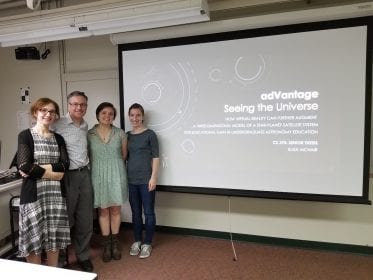 This thesis introduces the “adVantage – Seeing the Universe” system, a learning environment designed to augment introductory undergraduate astronomy education. The goal of the adVantage project is to show how an immersive virtual reality (VR) environment can be used effectively to model the relative sizes and distances between objects in space. To this end, adVantage leverages the benefits of three-dimensional models by letting users observe and interact with astronomical phenomena from multiple perspectives. The system uses pre-set vantage points to structure students’ progress through a variety of “missions” designed to improve their understanding of scale. The adVantage system departs from two-dimensional, textbook illustrations by adding navigable depths to a star-planet-satellite system, and distinguishes itself from existing pedagogical 3D space-simulation environments (that we know of) by establishing a laboratory for student investigation. Students exploring in adVantage will be able to observe the relative sizes and orbital movements of the subjects of the system: e.g., the exoplanet WASP-12b, its Sun-like star, WASP-12, and imagined satellites constructed to resemble the Earth and its Moon. This combination of astronomical bodies will engage students by introducing the new star-exoplanet system and provide context by incorporating familiar elements. We have already implemented a JavaScript prototype of the adVantage system and are developing the VR system using the game engine Unity and the VR system SteamVR. Students will interact with adVantage using a HTC Vive headset and hand controllers. We will carry out preliminary investigations of student response to the system when the immersive version of adVantage is complete.
This thesis introduces the “adVantage – Seeing the Universe” system, a learning environment designed to augment introductory undergraduate astronomy education. The goal of the adVantage project is to show how an immersive virtual reality (VR) environment can be used effectively to model the relative sizes and distances between objects in space. To this end, adVantage leverages the benefits of three-dimensional models by letting users observe and interact with astronomical phenomena from multiple perspectives. The system uses pre-set vantage points to structure students’ progress through a variety of “missions” designed to improve their understanding of scale. The adVantage system departs from two-dimensional, textbook illustrations by adding navigable depths to a star-planet-satellite system, and distinguishes itself from existing pedagogical 3D space-simulation environments (that we know of) by establishing a laboratory for student investigation. Students exploring in adVantage will be able to observe the relative sizes and orbital movements of the subjects of the system: e.g., the exoplanet WASP-12b, its Sun-like star, WASP-12, and imagined satellites constructed to resemble the Earth and its Moon. This combination of astronomical bodies will engage students by introducing the new star-exoplanet system and provide context by incorporating familiar elements. We have already implemented a JavaScript prototype of the adVantage system and are developing the VR system using the game engine Unity and the VR system SteamVR. Students will interact with adVantage using a HTC Vive headset and hand controllers. We will carry out preliminary investigations of student response to the system when the immersive version of adVantage is complete.
Valerie Zhao ’18
Evaluation of Dynamic Binary Instrumentation Approaches: Dynamic Binary Translation vs. Dynamic Probe Injection
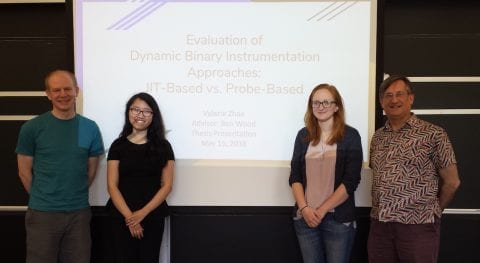 From web browsing to bank transactions, to data analysis and robot automation, just about any task necessitates or benefits from the use of software. Ensuring a piece of software to be effective requires profiling the program’s behavior to evaluate its performance, debugging the program to fix incorrect behaviors, and examining the program to detect security flaws. These tasks are made possible by instrumentation—the method of inserting code into a program to collect data about its behavior. Dynamic binary instrumentation (DBI) enables programmers to understand and reason about program behavior by inserting code into a binary during run time to collect relevant data, and is more flexible than static or source-code instrumentation, but incurs run-time overhead. This thesis attempts to extend the preexisting characterization of the tradeoffs between dynamic binary translation (DBT) and dynamic probe injection (DPI), two popular DBI approaches, using Pin and LiteInst as sample frameworks. It also describes extensions to the LiteInst framework that enable it to instrument function boundaries more effectively. Evaluations found that LiteInst performed up to 80× slower than the original binary run time, while Pin had at most 10× slow-down, suggesting that DBT is more efficient in some aspects.
From web browsing to bank transactions, to data analysis and robot automation, just about any task necessitates or benefits from the use of software. Ensuring a piece of software to be effective requires profiling the program’s behavior to evaluate its performance, debugging the program to fix incorrect behaviors, and examining the program to detect security flaws. These tasks are made possible by instrumentation—the method of inserting code into a program to collect data about its behavior. Dynamic binary instrumentation (DBI) enables programmers to understand and reason about program behavior by inserting code into a binary during run time to collect relevant data, and is more flexible than static or source-code instrumentation, but incurs run-time overhead. This thesis attempts to extend the preexisting characterization of the tradeoffs between dynamic binary translation (DBT) and dynamic probe injection (DPI), two popular DBI approaches, using Pin and LiteInst as sample frameworks. It also describes extensions to the LiteInst framework that enable it to instrument function boundaries more effectively. Evaluations found that LiteInst performed up to 80× slower than the original binary run time, while Pin had at most 10× slow-down, suggesting that DBT is more efficient in some aspects.
Maja Svanberg ’18
Suggested Blocks: Using Neural Networks To Aid Novice Programmers In App Inventor
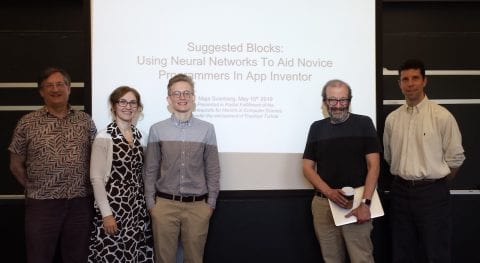 MIT App Inventor is a programming environment in which users build Android applications by connecting blocks together. Because its main audience is beginner programmers, it is important that users are given the proper guidance and instruction to successfully become creators. In order to offer this help, App Inventor provides text-based tutorials that describe the workflow of example programs to users. However, studies have shown that out-of-context help such as tutorials has little to no effect on learning, and when given the choice, users prefer in-context hints and suggestions. In order for users to overcome some of the barriers with self-training, we need to provide them with relevant information and in-context suggestions. Therefore, I am introducing Suggested Blocks, a data-driven model that leverages machine learning to provide users with relevant suggestions of which blocks to include in their programs.
MIT App Inventor is a programming environment in which users build Android applications by connecting blocks together. Because its main audience is beginner programmers, it is important that users are given the proper guidance and instruction to successfully become creators. In order to offer this help, App Inventor provides text-based tutorials that describe the workflow of example programs to users. However, studies have shown that out-of-context help such as tutorials has little to no effect on learning, and when given the choice, users prefer in-context hints and suggestions. In order for users to overcome some of the barriers with self-training, we need to provide them with relevant information and in-context suggestions. Therefore, I am introducing Suggested Blocks, a data-driven model that leverages machine learning to provide users with relevant suggestions of which blocks to include in their programs.
In this project, I focused on developing the neural networks to power a suggested blocks system. Using original apps from real App Inventor users, I developed a set of experiments to discover plausible vector representations of the data, including tree traversals, n-grams, tree structures, as well as different network architectures to generate the best possible block suggestions for the users. The objective is not only to be accurate, but to provide suggestions that are sensible, relevant, and most importantly, educational. When simulating the best model on reconstructing an original project from a novice user, suggesting only 10 blocks at a time, the user would be able to drag- and-drop 60% of her blocks straight form the Suggested Blocks drawer. Overall, the results show promise for a future implementation of a Suggested Blocks system.
According to the SRC website:
“Held every spring, SURA’s annual conference serves as a forum where undergraduates from all over the country can present their work, connect with other researchers, and hear from distinguished leaders in the research community. Students who share their findings accordingly will receive valuable feedback from the students, alumni, and faculty members in attendance—feedback that will help them develop their interests further or redirect their efforts altogether. Students currently not participating in research may find a project that inspires them to explore an idea of their own. In this fashion, the conference will facilitate the exchange of information that is necessary for intellectual advancement in today’s highly interconnected society.”
This year about 10% of the posters at the conference won that award. We are very pleased to have Hannah’s poster picked out of about 100 posters this year!
Valerie Zhao ’18 was recognized with an Honorable Mention in the 2018 Computing Research Association Outstanding Undergraduate Researcher Awards. Valerie’s summer research was previously featured here. Valerie is currently pursuing research on the design of dynamic binary instrumentation tools for analyzing software at the machine code level, advised by Ben Wood.
Valerie Zhao ’18 and Ben Wood participated in SPLASH 2017, the ACM SIGPLAN Conference on Systems, Programming Languages, Applications: Software for Humanity, in Vancouver, BC, in late October. SPLASH is an umbrella for several conferences and workshops in the area of programming languages.
Valerie won 3rd prize in the undergraduate category of the Student Research Competition, where she presented a poster and talk on her summer research work, Abstracting Resource Effects, undertaken at Carnegie Mellon University with Darya Melicher, Jonathan Aldrich, and Alex Potanin. Valerie’s collaborator Darya Melicher, a PhD student at CMU, presented more of their work at the OCAP workshop. Their work introduces a novel effect system that supports rigorous checking of how programs use system resources in a security-focused programming language.
Ben gave a talk on his OOPSLA paper, Instrumentation Bias for Dynamic Data Race Detection, with collaborators from Google, The Ohio State University, and the University of Washington. Their work introduced a software system for accurately detecting data races, a problematic type of concurrent programming error. The analysis helps eliminate a source of performance overhead in error detection by exploiting properties of common program patterns.
Earlier in October, Ben’s collaborator gave a talk on their paper, PARSNIP: Performant Architecture for Race Safety with No Impact on Precision, at the 50th ACM/IEEE Symposium on Microarchitecture (MICRO), in Cambridge. This work, with collaborators at U. Penn, designed efficient hardware support for data race detection that, combined with software techniques, could eventually provide always-on concurrency error detection much like modern memory-safe languages provide explicit runtime exceptions for null dereferences or array bounds errors.
